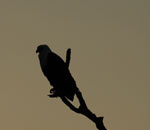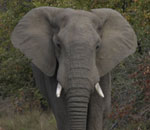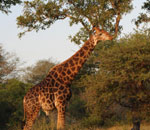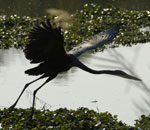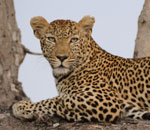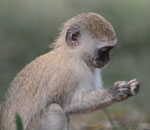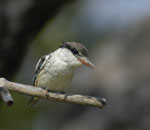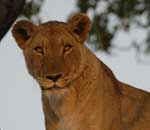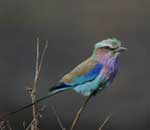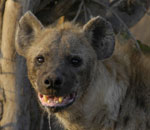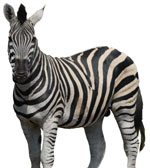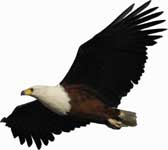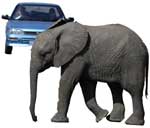When to Go on Safari
Much has been written about the best time of year to go on safari, Kruger
is a year-round destination in a vast and diverse area and wildlife is
the major attraction. The year can be roughly split into two seasons.
The Wet Season - which is the warmer months of November
to March.
The grass can be long in some areas after the rains and everything is
lush and green, and the birding is excellent. November and December are
the calving months. The animals and birds are in good condition with ample
supply of water and food.
The Dry Season – Which is the warm days but cooler
nights of April to October. It is easier to spot game as the vegetation
is less dense, grass is shorter and water is restricted to rivers
and waterholes, where the wildlife congregates.
The optimum safari season is May to August and the hot
months of September and October. The climate is comfortable in the dry
winter months of May, June, July and August. Daytime temperatures are
mild and the nights get a little cool.
Peak Seasons
Peak season is when the lodges are busiest – not necessarily when
it is the best time of year to visit, for example December is peak season
because the lodges can always fill the beds, while July is often a quieter
moth at the lodges but is a great time for game viewing.
Many Safari Lodges are small, and therefore space is at a premium for
peak seasons it is advisable to book well in advance.
Photography on Safari
You will have the opportunity to take some amazing photo's while
on your safari.
On guided Kruger Safaris talk to your Ranger before the Game drives
and bush walks and he can guide you as to what you are likely to
see and help position you best on the drives for light and angles.
It is helpful to know the behaviour of the animals and birds you're
trying to photograph. By understanding their behaviour you will
have a better chance of finding them and you will be able to predict
their actions.
Never interfere with the natural behaviour of the animals in order
to take a better photo! Please be courteous when taking pictures.
Camera equipment
Now is the age of the digital camera and even small compacts have
great capabilities. Remember batteries and memory cards, however
large your memory card is it never seems enough when there is a
lion only a few metres away from your vehicle !!
Lenses
A 200 or 300mm lens (or 80-300 zoom) is good for most wildlife
photography from vehicles. A 400 or 500mm range lens will work well
in many situations, especially if you are a keen bird photographer.
A 24 to 35mm is great for landscapes and a 50mm to 90mm is good
for people.
The new super lenses that go from 50 to 400mm are ideal for going
across the whole range.
Filters and Tripods
Skylight and UV filters are useful for lens protection as well
as picture enhancement. Polarizing filters are useful when taking
pictures over water and with wide-angle shots with sky and clouds.
It is very difficult to use a tripod on safari either a guided
or self drive, a better idea is a small beanbag for resting your
camera and lens. We suggest that you make the bag at home (approx.
6'x 9') with a good sealed zip at one end and fill it with rice
purchased when you arrive (keep the rice in its purchase bag so
at the end you can give it away).
New Equipment
If you buy new camera equipment before this safari, make sure
you are completely familiar with it's operation before you leave,
check things like type of battery you will need (common AA style
batteries are available but other types are difficult to get). For
rechargeable batteries check when and where you can recharge them,
always carry a spare.
Some Safari Photography Tips
When taking close-up pictures, focus on the animal's eyes. This
guarantees that most of the animal's face will be in focus. Be prepared
and ready with your camera at all times, as animals may suddenly
appear and disappear just as quickly.
Range your subject. For example, when taking photos of an Elephant,
take a portrait shot; include one more with the general habitat
in context to the subject, then another with close-up detail, such
as tusks and face.
Take different pictures in vertical and horizontal approaches.
Take photographs from different levels when you are on a game viewing
activity. Remember pictures taken at the animal's eye-level will
appear more sensational.
Do not centre all your shots; leave room in your subject for the
animal to move into. This will prevent lifeless composition and
give an imitate portrayal of your subject.
A good starting point for wildlife photography is a lens with a
300mm in focal length. Bird photography will require a 500mm lens.
When the subject is in motion, use a shutter speed of at least 1/125,
except if you are using a panning method. Birds in flight necessitate
speeds of 1/500 or more.
You will find incredible photographic opportunities on your safari.
If you are a keen photographer you may want to bring two SLR camera
bodies so you will not have to change lenses. With two cameras you
will spend more time looking at the wildlife and composing shots
rather than fumbling in your camera bag, getting dust in your camera
body, and missing the action!
Our Camera Equipment at Kruger Park Safari Service
The shots on this website are all taken by the staff in the White
River office and we run special photographic safaris where our photographer
will accompany you on Safari and help you brush up on wildlife safari
shots.
We use Nikon Equipment for our photography and have the following:
Bodies: D300, D200, D70 and D40x
Lenses: Sigma 10 - 20 mm, Nikon 17 – 55 mm Nikon 300 mm, Nikon
200 – 400 mm and a 1.7 times converter.
What to wear on Safari
On safari, most people wear shorts and a T-shirt during the day
and put on long sleeved shirts and long pants in the evening for
warmth as well as protection from mosquitoes. Should you be particularly
sensitive to the sun a loose cotton shirt is essential during the
day. Khaki, brown, olive and beige colours are best for and safaris
and game walks.
White is not a suitable colour for these activities, as it increases
your visibility to wildlife you want to get a closer look at and
it will get dirty very quickly. Fleece or sweater and a windbreaker
for game drives, because it is highly possible that you may go out
on a hot day, but be faced with a chill evening on your return.
Remember that layering your clothing will keep you warmer than relying
on one thick item.
A suggestion of what to pack
- pairs khaki cotton pants
- pairs khaki shorts
- long sleeved shirts/ blouses (for sun protection as well as warmth)
- light sweater or sweatshirt
- lightweight, waterproof windbreaker
- Swimming costume
- Sturdy walking or hiking boots
- Sandals
- short-sleeved shirts or T-shirts
- changes underwear and socks
- Hat with a brim (baseball caps might cover your nose but not your
ears and neck)
- Camera, and sufficient memory card(s)
- Spare batteries. Some batteries can generally be obtained at lodges,
but at a price of course, so please be sure to have sufficient supplies
for your needs
- Binoculars
- Paperback reading, writing material (keep weight at a minimum)
- Sunscreen or block
- Moisturizer, lip balm
- Personal first-aid kit (headache pills, antihistamine cream etc)
If you take prescription medication, be sure to bring a sufficient
supply with you. If you are on a lengthy holiday, we suggest that
you carry a copy of your prescription with you.
Creepy Crawlies
Although Africa is known to be home to a number of potentially
dangerous species, especially snakes, scorpions, spiders, and insects,
very few visitors are adversely affected. Snakes tend to be shy,
and generally stay away from built-up areas. Lodges and camps generally
have insect (especially mosquito) proofing in their rooms. If you
go on a walk, it is always a good idea to wear comfortable, enclosed
walking shoes, socks, and long trousers – just as a precaution.
And Please
Litter tossed on the ground can choke or poison animals and birds
and is unsightly. Refrain from smoking on game drives. The dry African
bush ignites very easily, and a flash fire can kill many animals.
Never attempt to feed or approach any wild animal on foot. This
is especially important near lodges or in campsites where animals
may have become accustomed to human visitors.
| 
